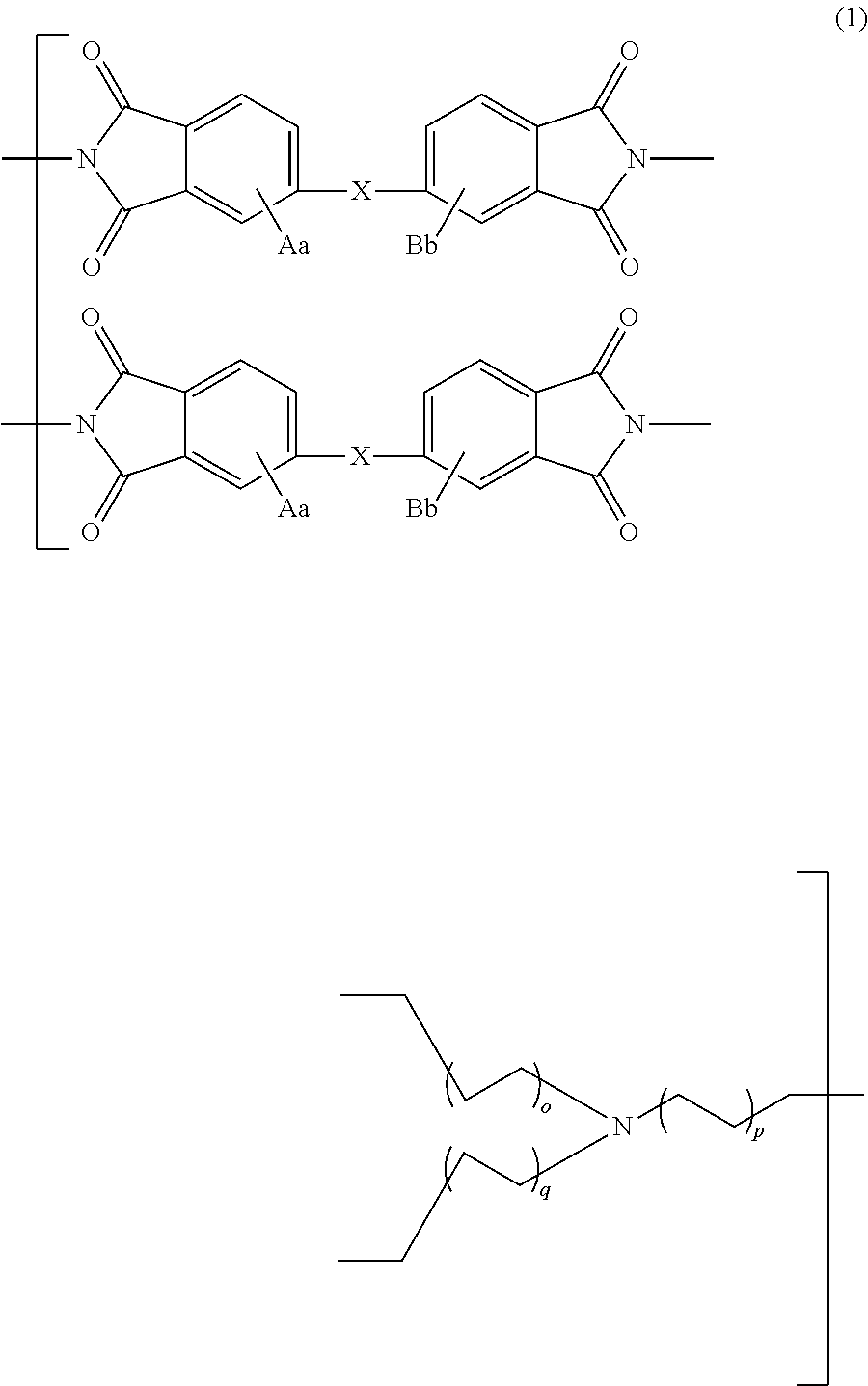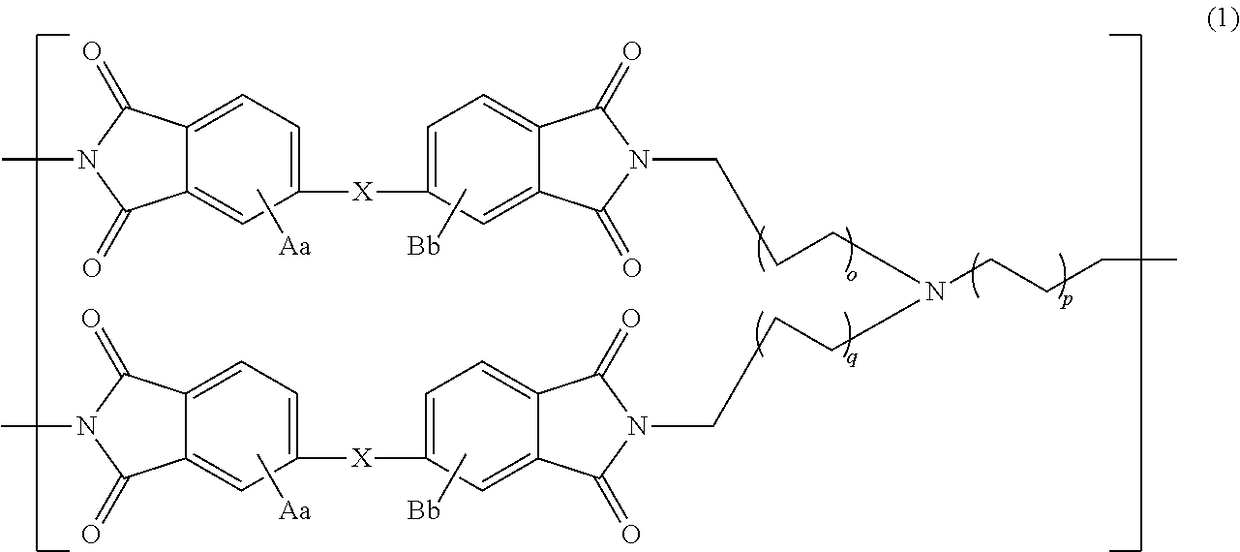Polyimide compound, preparation method therefor, and optical film and optical waveguide produced by employing the compound
a technology of polyimide compound and preparation method, which is applied in the field of polyimide compound, can solve the problems of thermal warpage (or curvature) of the board, and it is difficult to form a coating film by applying a resin composition, and achieves the effect of significantly suppressing the low linear expansion coefficient and low linear expansion coefficien
- Summary
- Abstract
- Description
- Claims
- Application Information
AI Technical Summary
Benefits of technology
Problems solved by technology
Method used
Image
Examples
example 1
Synthesis of Polyamic Acid Solution
[0045]First, 3.41 g of 2,2-bis(3-amino-4-hydroxyphenyl)hexafluoropropane and 135.5 mg of tris(3-aminopropyl)amine were blended in a reaction vessel provided with a stirrer, and dissolved in 20.2 ml of dry N,N-dimethylacetamide. Then, 4.60 g of 4,4′-(hexafluoroisopropylidene)diphthalic dianhydride was slowly added to the resulting solution with stirring, and the resulting mixture was further stirred at 40° C. for 5 hours. Thus, an N,N-dimethylacetamide solution of a polyamic acid (polyimide precursor) was prepared (which had a solid concentration of 30%, an overall weight of 27.0 g and a trifunctional amine proportion of 7 mol %).
Production of Polyimide Film
[0046]The solution of the polyamic acid thus prepared was applied onto a glass substrate by a spin coating method. The resulting coating film was pre-baked for 15 minutes on a hot plate heated at 90° C., and then further heated at 300° C. at a reduced pressure for 2 hours, whereby the polyamic ac...
example 2
[0047]First, 3.48 g of 2,2-bis(3-amino-4-hydroxyphenyl)hexafluoropropane and 95 mg of tris(3-aminopropyl)amine were blended in a reaction vessel provided with a stirrer, and dissolved in 20.2 ml of dry N,N-dimethylacetamide. Then, 4.55 g of 4,4′-(hexafluoroisopropylidene)diphthalic dianhydride was slowly added to the resulting solution with stirring, and the resulting mixture was further stirred at 40° C. for 5 hours. Thus, an N,N-dimethylacetamide solution of a polyamic acid (polyimide precursor) was prepared (which had a solid concentration of 30%, an overall weight of 27.0 g and a trifunctional amine proportion of 5 mol %).
[0048]With the use of the solution of the polyamic acid thus prepared, a polyimide film (having a thickness of 5.6 μm) was produced in substantially the same manner as in Example 1.
example 3
[0049]First, 3.55 g of 2,2-bis(3-amino-4-hydroxyphenyl)hexafluoropropane and 55.6 mg of tris(3-aminopropyl) amine were blended in a reaction vessel provided with a stirrer, and dissolved in 20.2 ml of dry N,N-dimethylacetamide. Then, 4.51 g of 4,4′-(hexafluoroisopropylidene)diphthalic dianhydride was slowly added to the resulting solution with stirring, and the resulting mixture was further stirred at 40° C. for 5 hours. Thus, an N,N-dimethylacetamide solution of a polyamic acid (polyimide precursor) was prepared (which had a solid concentration of 30%, an overall weight of 26.5 g and a trifunctional amine proportion of 3 mol %).
[0050]With the use of the solution of the polyamic acid thus prepared, a polyimide film (having a thickness of 5.0 μm) was produced in substantially the same manner as in Example 1.
PUM
| Property | Measurement | Unit |
|---|---|---|
| temperature | aaaaa | aaaaa |
| temperature | aaaaa | aaaaa |
| temperature | aaaaa | aaaaa |
Abstract
Description
Claims
Application Information
 Login to View More
Login to View More - R&D
- Intellectual Property
- Life Sciences
- Materials
- Tech Scout
- Unparalleled Data Quality
- Higher Quality Content
- 60% Fewer Hallucinations
Browse by: Latest US Patents, China's latest patents, Technical Efficacy Thesaurus, Application Domain, Technology Topic, Popular Technical Reports.
© 2025 PatSnap. All rights reserved.Legal|Privacy policy|Modern Slavery Act Transparency Statement|Sitemap|About US| Contact US: help@patsnap.com



